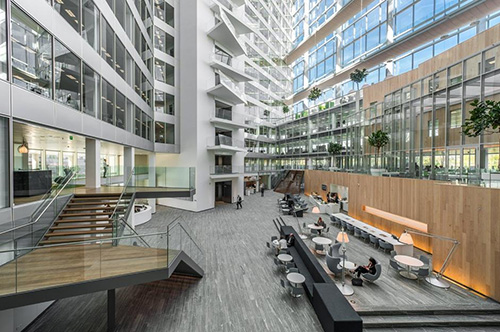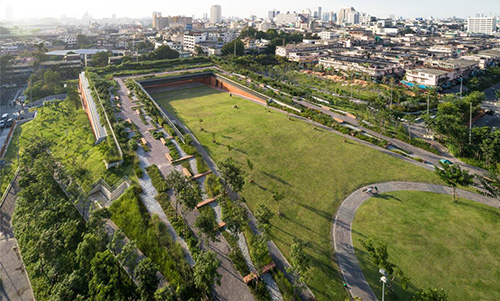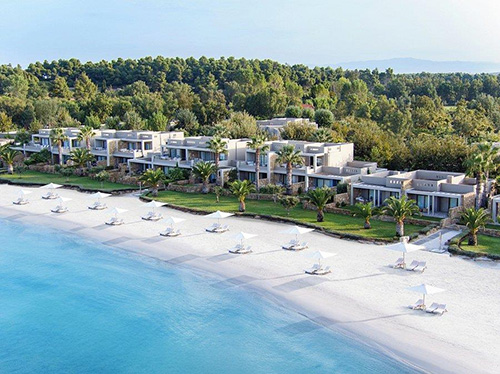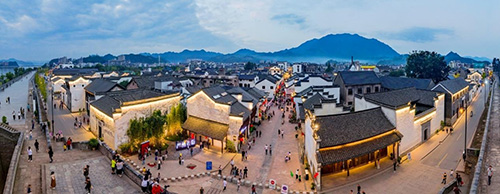Recommended Sustainability Cases
1. CITICAP project in Lahti, Finland
The Finnish city of Lahti has already committed to carbon neutrality by 2025 and it has developed the world’s first public carbon-trading scheme and digital application for its residents, which is known as CitiCAP project (Citizens’ cap-and-trade co-created). The main goals of the project are to reduce traffic congestion and emissions from transport, collect and make available digital data on mobility, and develop new transport services for citizens, enable and promote sustainable urban mobility in Lahti. The digital application enabled real-time tracking and visualization of one’s mobility carbon footprint.
CitiCAP was an EU-funded project and its duration was from January of 2018 to March of 2021. The emissions trading took place using a mobile application that automatically identified the mode of transportation of its user and visualized emissions from mobility. The app calculated a personal emission budget for the user based on their life situation. For those who went below the budget, virtual credits were accumulated, which were able to be exchanged for various products and discounts on the application's marketplace, for example tickets to local swimming hall. More than one in three users (36%) declared that they have reduced their mobility emissions as a result of the application.
CitiCAP developed a model for designing the bicycle route network, by building a 2.5 km smart bicycle highway that highlights by example the importance of safe cycling infrastructure. Various smart solutions are being tested on the bicycle lane to improve the cycling experience. The CitiCAP bicycle path is part of Lahti’s cycling network plan 2030, which consists of about 60 kilometers of main cycling routes. (More: https://www.lahti.fi/en/housing-and-environment/transportation-and-streets/citicap/)
2. City Leap Initiative in Bristol, United Kingdom
Bristol was the first UK city to declare a climate emergency and have committed to being a carbon neutral city by 2030. Since 2005, Bristol City Council has delivered a wide programme of energy efficiency and investment initiatives, investing tens of millions of pounds in renewable energy generation and energy efficiency and meeting our 2020 corporate carbon reduction target three years early.
The council launched the City Leap initiative in 2018. The aim of City Leap is to take advantage of the transition to a decentralised energy system to build an interconnected, low carbon, smart energy system that delivers social, environmental and economic benefits for the people of Bristol, building on the innovative leadership the council has shown in energy and sustainability over almost three decades.
The City Leap Energy Partnership initiative is an ambitious new approach to partnership between the public and private sector. It will accelerate the city rapidly towards the 2030 goal and attract £1 billion of new investment into Bristol’s energy projects. Procurement to select a partner that has the scale, resources and capacity to deliver and support the creation of a zero-carbon, smart energy city by 2030 is in the final stages. The partnership will also deliver significant social and economic benefits such as jobs, clean air and warmer healthier homes.
(More: https://www.energyservicebristol.co.uk/cityleap/)
3. The Edge, Amsterdam, The Netherlands
The Edge, a 40,000m² building which Deloitte shares with other tenants, was designed by PLP Architecture and developed by Edge Technologies. It sets a new global benchmark for the office environment by prioritising the comfort, health and productivity of its end-users. The project became the world’s most sustainable office building, having been awarded a BREEAM new construction certification of ‘Outstanding’ and a score of 98.36 per cent.
At The Edge, the workers live in digital synergy with their building. Sensors in all spaces provide data to the building’s smart environmental management systems and all office equipment is connected through the IoT. The workers communicate their specific requirements directly to the building through their smartphones, and the building learns to provide the most sustainable, safe, pleasant and productive workplace setting.
The roof and south-facing façade incorporate the largest array of photovoltaic panels of any European office building. The installation of off-site solar panels has allowed the building to produce more energy than it consumes. The workspace is organised around a grand 15-storey atrium providing most of the floorplates with north light. The expansive space, bright and active, contributes to an inspirational business environment that is operationally, aesthetically and environmentally outstanding. The atrium is the lung of the building, ventilating the office space, while the load-bearing structure and smaller glazed openings of the sun-lit facades provide thermal mass and shade. In addition to its role in the environmental strategy, the glowing atrium becomes a window into Amsterdam’s Zuidas.
(More: http://www.plparchitecture.com/the-edge.html)
4. Functional and sustainable homes in the Metropolitan Area of Barcelona, Spain
Throughout the Metropolitan Area of Barcelona, 1,327 protected homes are under construction in different phases to respond to the need for multifunctional spaces that can allow for teleworking and coexisting. The new development of 85 flats in the old Pisa Cinema in Cornellà de Llobregat is managed by IMPSOL (The Metropolitan Institute of Land Development and Property Management from AMB) and designed by architects Peris+Toral. The flats are a clear example of modern functional and sustainable homes designed both for the traditional family model and for new ways of living, all while being accessible to people of limited means.
The houses are made up of five, six, or seven communicating rooms built around a courtyard, and situate the kitchen in the centre of the home. This allows for a better distribution of spaces, replacing corridors and making domestic work more visible, and helping to avoid gender roles. In addition to offering flexibility based on an ambiguity of use, the building is largely constructed out of wood.
Sustainability is one of the main axes of this housing development. The objective is to minimize CO2 emissions, waste generated during construction, and subsequent energy demand. This has allowed for the obtainment of an A Energy Rating thanks to the environmental strategies implemented, such as the incorporation of recycled and recyclable materials such as the wooden structure, the reduction of energy demand thanks to the insulation and cross-ventilation, the use of high energy efficiency facilities through the aerothermal system for heating and hot water production and the production of electricity through photovoltaic panels for community services.
5. Smart Environment Program in Dubai, United Arab Emirates
In line with its vision to develop a happy and sustainable city, Dubai Municipality has been leading the way in sustaining and monitoring of air quality. This was reinforced with the introduction of the Mobile Air Environment Monitoring Station (MAEMS), the first of its kind air quality mobile station in the Middle East, designed to monitor over 100 air pollutants.
The vehicle serves as a mobile environmental operation room and was designed to monitor ambient air pollutants emitted from operational processes across a range of different sectors including the industrial, transportation, energy sectors and a range of service facilities. Since the start of its operation, the MAEMS has been utilized in the successful conduct of several studies, environmental surveys and environmental awareness campaigns within Dubai Emirate, contributing largely in the achievement of a number of strategic, technical, legal and social outcomes and adding great value to the existing air quality monitoring network stations of air, odor, noise and EMF.
The Mobile Air Environment Monitoring Station is equipped with over 20 advanced monitoring technologies. On-site calibration is undertaken for each of the monitoring devices on board the mobile station as per the ISO/IEC 17025 accreditation requirements. The station has built-in communication and self-monitoring security devices and advanced computer programs to process and analyze the data that are displayed on the smart screen located inside the station. The mobile station conforms with Euro 5 engine specifications, and is equipped with solar panels and run on biofuel for renewable energy sources. The MAEMS campaigns specifically inform the public on the relevance of measuring and monitoring air pollutants to assess local human health effects and to evaluate progress towards the improvement of air quality.
(More: http://www.dubaiairenvironment.dm.gov.ae/mobile_air_monitoring)
6. Green technology for upcycling, Miniwiz, Taiwan
mini-TRASHPRESSO is the world’s first zero-waste mobile upcycling system, showcasing MINIWIZ's proprietary technology, used in creating its circular ESG building modules. Miniwiz has fully implemented 96 beds medical pods system call MAC Ward system with convertible ICUs, negative pressure isolation wards, and regular surgery recovery rooms all made from trash locally collected and locally manufactured while it passes international medical grade certification in fire proof, isolation rating, and anti-bacterial/ antiviral surfacing. mini-TRASHPRESSO was designed to tackle waste by creating a mobile, semi-automated, and self-powered, industrial grade recycling platform.
Powered by robotics, machine learning & AI, the machine’s unique end-to-end functionalities include trash collection, sorting, and real-time transformation of waste into valuable materials and components used in buildings, exterior/interior decorative, and lifestyle accessories. The upcycled experimental products have already been utilized in over 300,000sqm of commercial retail, hotels and offices across major international cities.
It leapfrogs existing technology and empowers the circular economy by (a) democratizing the collection, sorting and transformation of waste; (b) decentralizing plastic waste management and transformation without secondary pollution; (c) minimizing air/water footprint to almost ZERO impact with just 7kwh power consumption; (d) servicing up to 10,000 inhabitant community; 500kg of plastic waste/day; (e) utilizing AI material recognition, smart digital mechanical forging process, robotic automation; and (f) generating tangible value through turning single-use plastic trash into valuable applications (building materials, utensils, etc.) 3 minutes/cycle. (More: https://trashpresso.com/)
7. Tamarinden – Sweden’s Smartest District
Tamarinden is located in Sörbyängen, an expansive area in southern Örebro and will consist of 600 housing units. The ambitions are to create a district where the buildings will reduce, produce, and share energy in a way that has never been done before.
The buildings will be able to share electricity and heat in a local energy network. Each building will be given the opportunity to connect to the local energy network and be built with solar cells, batteries and a control unit that can be connected to a district level. Data from the buildings and information such as lack of power as well as weather and electricity price forecasts form the basis for an optimized energy use. Through new business models and services, the buildings also will support the energy system with flexibility, energy efficiency and peak shaving.
If one building has an overproduction while another has a lack, the energy can be distributed to the building that needs it at the current time. The buildings in Tamarinden will thus help to cover each other's energy needs before they buy and take energy from the main grid. A unique solution that paves the way for new energy-smart districts in Sweden. Through the area, Tamarindvägen, which serves as an urban street and living room, is paved. Here the car is allowed to stand aside in favor of human stay and movement, which becomes possible when car parking is solved at the outer edges of the area. Tamarinden has one foot in the city with access to public transport and a well-developed pedestrian and bicycle network for easy access to the city center and nearby workplaces. The other foot is located in the scenic surroundings.
(More: https://en.elfack.com/2020/06/tamarinden-swedens-smartest-district/)
8. Community Resilience Hubs in Baltimore, United States
The Community Resiliency Hub Program is an innovative and impactful community-centered initiative that increases community capacity to prepare for, withstand, and respond to natural hazard impacts and emergency situations. The goal of this program is to better connect frontline community organizations with focused support and resources so that, in the event of a natural disaster or emergency, there is improved provision of emergency response and recovery services to under-resourced neighborhoods and their most vulnerable residents. There are currently twelve Resiliency Hub partner organizations in the program.
Community Resiliency Hubs receive grant-funded support from the City in many forms including high-quality emergency preparedness supplies, energy efficiency upgrades to their building, back-up power capabilities (rooftop solar + battery storage if feasible), emergency preparedness and response training, connections to grant funding opportunities, and focused support and communications from the Office of Sustainability (BoS), Office of Emergency Management (OEM), and Department of Health (BCHD).
A priority goal of the Program is to outfit Community Resiliency Hub partner organizations with solar power and battery back-up capabilities. This helps increase access to renewable energy and back-up power in low to moderate income communities, reduces the utility cost burden for community organizations, and provides community training and workforce development opportunities. Four Community Resiliency Hubs already have solar and battery back-up capabilities. Grant-funding is a critical piece to enabling the expansion of this work. This is an ongoing collaborative effort that involves many project partners.
(More: https://www.baltimoresustainability.org/baltimore-resiliency-hub-program/)
9. Chulalongkorn University Centenary Park – a green infrastructure in Bangkok, Thailand
Chulalongkorn University Centenary Park sets a model for re-implementation in the urban and peri-urban areas of Bangkok and other sinking cities how the park can sustainably become an integral part of climate adaptation. By harnessing the power of gravity, the park is able to sustainably collect, treat and hold water to reduce urban flood risks. Sitting on a 3-degree gradual incline, the park equipped with several ecological components - consisting of the green roof, wetlands, detention lawns, and retention pond leaves not a single drop of rain wasted. The runoff is pulled down through the park’s topography to generate a complete water circulation system. The park is able to hold up to a million gallons of water and can also use the collected rain to irrigate itself for up to a month during dry spells.
The park offers a complete water circulation and management system that addresses both irregular weather patterns and the city’s dysfunctional public sewage. As water flows down through the park’s inclined detention lawn, it is filtered and cleansed of water pollutants along the way. It is also able to recycle greywater from surrounding buildings and redistribute it for reuse. Visitors, too, can become an active part of the park's water treatment system by hopping onto stationary water bikes along the park’s retention pond and use their exercise to keep the water aerated.
The 5200m2 green roof is the catch basin for water. It is planted with native grasses and weeds for low maintenance: the plants can withstand Thailand’s extremely hot and wet seasons, and need minimal irrigation. With a variety of 258 plants and 5,000 forest trees, the park delivers nature back to the city and provides a new home and microclimate for pollinators and insects. All organic waste produced by plants and trees in this park are collected to process into organic fertilizer and return to its ground and other green areas around the campus.
(More: https://landprocessdesign.wixsite.com/landprocess/cucentenarypark)
10. East Kolkata Wetlands – The world’s largest organic sewage management system
East Kolkata Wetlands is a vast network of man-made wetlands bordered by green embankments and channels. Kolkata produces around 750 million liters of wastewater as well as sewage every day. Through bio-remediation, the waterways clean the city’s wastewater in less than 20 days. The purified nutrient-rich water is then channeled into ponds where algae and fish thrive.
Urban waste water supplied by the municipal corporation is routed through a series of small inlets, each managed by a fishery cooperative. The cooperatives control the inflow of the waste water, they let it settle so that only the clear top layers of water flow into the shallow wetland. A parabolic fish gate separates the wetland water from the waste water. The parabolic structure is there to prevent fish swimming into the oxygen-less urban waste water, where they would die. In the meantime, nature does its work. In the inlets, organic waste settles down and is partly decomposed in the warm shallow water. In a series of biological steps, the organic waste in the wetland is converted into fish feed. There are several ecological processes at work: soil bacteria, macro-algae, plant bacteria and plants themselves convert nitrate, and absorb phosphate and heavy metals. The sediments in the waste water settle down. As the water becomes less turbid, sunlight accelerates some of these processes.
In short, these wetlands are Kolkata’s free sewage remediation works, a fertile aquatic garden and, most importantly, a natural flood defense for the low-lying city.
(More: http://ekwma.in/ek/)
11. Bucuti & Tara Beach Resort in Aruba, Dutch Caribbean
Bucuti & Tara Beach Resort is located along Eagle Beach, Aruba, named one of the “Dream Beaches of the World,” and simultaneously, at just 0.8m above sea level, it is also one of the most vulnerable due to the devastating effects of rising sea levels from climate change. Owner/CEO Ewald Biemans began implementing sustainability initiatives into every aspect of the resort more than 30 years ago and by August 2018, it became the first and remains the Caribbean’s only carbon-neutral hotel.
Eco-certifications create its sustainability framework since each have a specialty and the combination that works best for Bucuti & Tara includes Green Globe Platinum, ISO 14001 and 9001, Travelife Gold, LEED Gold and Carbon Neutral. Employees receive continuous training and work in a setting that is as safety conscious for them as it is the guests they serve. A sampling of the all-encompassing efforts that are allowing Bucuti & Tara to excel beyond net zero include: sourcing renewable energy both wind and solar, solar heated water, sanitizing and repurposing grey water, 68% waste diversion including a dynamic Healthy Portions program, smart sensor air-conditioning, Variable Refrigerant Flow (VRF) technology, Energy-star and comparable-rated equipment, ozone-based laundry, methane reduction, smart transportation, 90% paperless, zero single-use plastic or Styrofoam, and green cleaning.
The resort is committed to hiring locally, actively leads community outreach efforts and shares best practices. The United Nations has deemed Bucuti & Tara’s sustainability program “highly replicable and scalable” for hotels worldwide to emulate. Next up, the resort is journeying to become carbon negative. (More: https://www.bucuti.com/resort/eco-friendly)
12. Sani Resort, Greece
Sani Resort, the first carbon neutral resort in Greece in 2020, is set in a 1,000-acre ecological reserve, with 7km of sandy beaches, over 20km of forest trails and 270-acres of wetlands, home to 225 bird species. Its “Sani Green” sustainability programme is underpinned by a range of initiatives supported by measurable targets, working towards the UN Sustainable Development Goals.
Sani Resort is powered by 100% certified renewable electricity, while it has reduced single-use plastic use by over 80%, aiming to be zero plastic and zero waste by 2024. The company is greatly increasing its renewable local energy capacity, while cutting down on carbon emissions, with an ambition to be net zero by 2030. Over 60% of its produce comes from within 100 miles and as part of Sani Green, various biodiversity projects are funded, such as the local Sani Wetlands Project, tree-planting, forest protection and preservation, as well as marine research and conservation initiatives.
Over 40 organizations are supported – such as schools, hospitals and refugee shelters - and scholarships are provided to encourage local farmers to farm more sustainably. Thousands of visitors, guests and schools take part in the Sani eco-excursions, ranging from birdwatching beekeeping trips, olive harvesting and day farm trips, and get immersed in the Sani Explorer eco-activities running for children. Sani Resort has received Blue Flag awards for its beaches, Green Key ecolabel, Travelife Gold Certification status and ISO14001 TUV Austria certification, among others.
(More: https://www.sani-resort.com/en_GB/sustainability)









